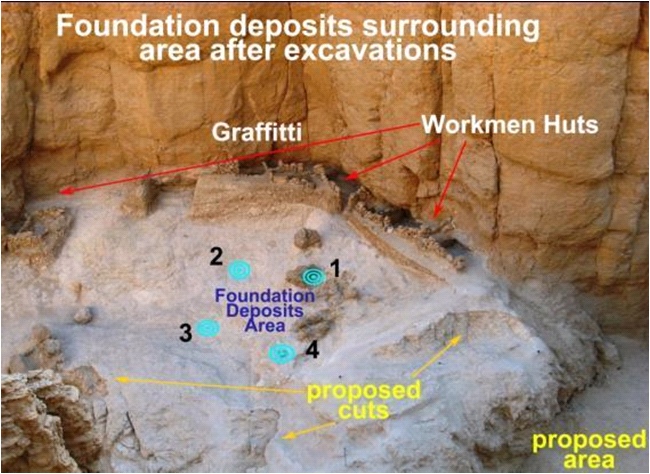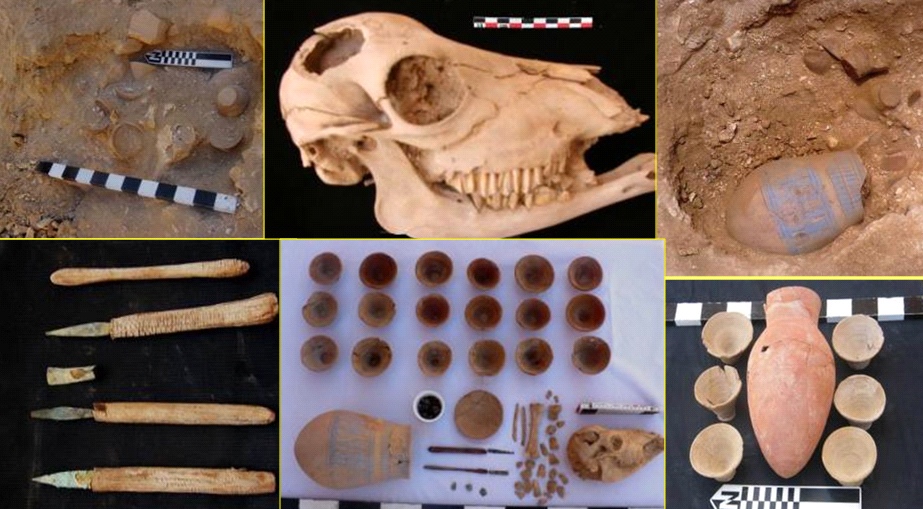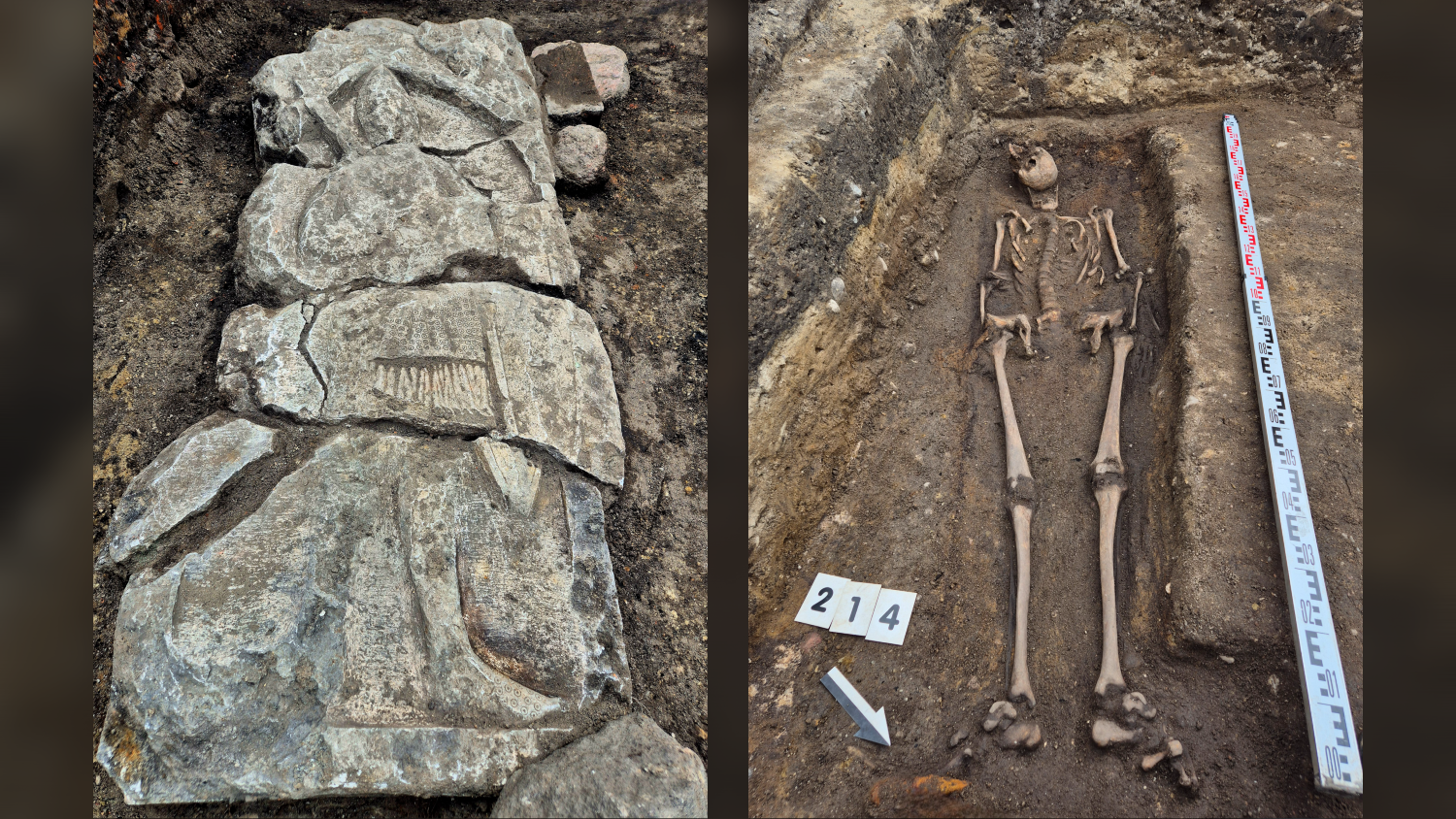Mysterious Buried Artifacts Discovered in Egypt's Valley of the Kings

Four deposits of artifacts possibly buried as a ritual act of sorts before the construction of a tomb have been discovered in Egypt's Valley of the Kings.
The so-called foundation deposits, arranged in a boxlike shape, contain a mix of artifacts, including the head of a cow, a vase painted in blue and flint blades that have wooden handles that are still preserved after more than three millennia.
The Valley of the Kings was used to bury Egyptian royalty during the New Kingdom (1550 – 1070 B.C.) period. The discovery was made in its "western valley," an area sometimes called the "valley of the monkeys" after a scene depicting 12 baboons was discovered in one of its tombs. [See Images of the New Discoveries and Egypt's Valley of the Kings]
"Previously discovered foundation deposits in the Valley of the Kings have always been associated with a nearby tomb," write Afifi Ghonim and Glen Dash in the abstract of a presentation they gave recently at the Current Research in Egyptology conference in London.

Ghonim, an archaeologist with the Egyptian Ministry of State for Antiquities, was field supervisor of the Egyptian expedition to the valley that took place between 2007 and 2011, and Dash led a team that did ground-penetrating radar work. This expedition, led by Zahi Hawass, was the largest since Howard Carter discovered King Tutankhamun's tomb in 1922. It has resulted in numerous discoveries and the collection of data, which will take many years to fully analyze and publish.
"We identified many new inscriptions, recorded many new workmen huts, and registered hundreds of distinctive finds, including ostraca [writing inscribed on pottery]. Our work in the western end of the Western Valley left us tantalizingly close to finding a new tomb," Ghonimtold the London audience. Their presentation in London focused on the team's work in the western valley. Additional finds made in other parts of the Valley of the Kings include anancient flood control system.
It's been an exciting month for Valley of the Kings research. In addition to news of the foundation deposits, a team from the University of Basel in Switzerland announced the discovery of the remains of 50 mummies (some of them children) in a tomb in the eastern valley.
Get the world’s most fascinating discoveries delivered straight to your inbox.
Ritual offerings
The newfound deposits were likely laid out as the foundation for a tomb.
"Foundation deposits are ritual offerings placed in front of or around a tomb or temple most likely at its commencement. While each deposit is only a square meter or less in size, such deposits contain a fascinating array of offerings," Ghonim told Live Science in an email.

"Usually included are miniature versions of the tools used in the tomb or temple's construction, miniature offering vessels sometimes with offerings intact, and food offerings such as a calf's head and limbs," he said. "Only a few foundation deposits have been found in the Valley of the Kings, and even fewer have been found intact."
The researchers suspect there is an undiscovered tomb nearby. "If there is one nearby, however, it is well hidden. Despite our determined efforts, we were not able to locate it," Ghonim said.
These foundation deposits are usually laid out so that four of them form a box shape and a fifth is placed on the axis of the tomb. "We found the four deposits that made up the box, but not the fifth. Perhaps it too is there, awaiting discovery in front of the tomb," Ghonim said.
Where's the Tomb?
It took several seasons for Carter to find King Tutankhamun's tomb in 1922, and, even with modern-day technology,finding a tomb in the Valley of the Kings is still challenging. [Photos: Egyptian Tomb Dating to Age of the Pyramids]
Perhaps there is no lurking tomb and the deposits were created for a tomb that was started but not completed, the researchers say.
If the deposits belong to an incomplete tomb, they may have been laid down for the burial of pharaoh Amenhotep IV or a member of his family. Amenhotep IV, who later changed his name toAkhenaten (also spelled Akhenaton), unleashed a religious revolution that saw Egyptian religion focus on the worship of the sun disk, the Aten. He built an entirely new capital at a place now called Amarna, but his revolution did not last, with his religious changes collapsing shortly after his death in 1336 BC.
"If it was Amenhotep IV, he would have begun construction here before abandoning the site and moving to Amarna as Akhenaton," Ghonim told the London audience. "The foundation deposits could have been laid down before the site was abandoned. Work here may then have begun again during the reign of Tutankhamen or Ay [his successors], and at that time the foundation deposits, now forgotten, were covered over with an additional layer of fill to level the area for the construction of workmen's huts."
Ghonim told Live Science that archaeologists are trying to determine a precise date for the foundation deposits, something that will shed light on this mystery.
Follow us @livescience, Facebook & Google+. Original article on Live Science.

Owen Jarus is a regular contributor to Live Science who writes about archaeology and humans' past. He has also written for The Independent (UK), The Canadian Press (CP) and The Associated Press (AP), among others. Owen has a bachelor of arts degree from the University of Toronto and a journalism degree from Ryerson University.
